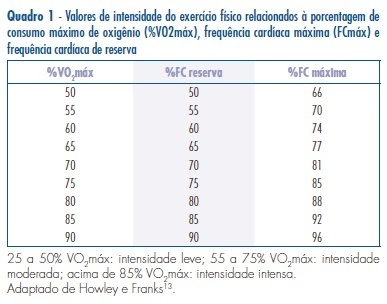Summary
Revista Brasileira de Ginecologia e Obstetrícia. 2009;31(5):254-261
DOI 10.1590/S0100-72032009000500009
It is believed that estrogen deficiency, lipid profile alterations, body weight gain, and sedentary lifestyle are strongly associated with the increased incidence of arterial hypertension in postmenopausal women. In an attempting to reduce the incidence of arterial hypertension in this population, a variety of approaches has been used, but the results are conflicting and the changing in lifestyle has been proposed and an important preventive action to control the arterial hypertension and associated risk factors in this women age - mainly practice of physical exercise. Continuous exercise has been used as an important approach in management cardiovascular disease and endocrine-metabolic disorders. Continuous exercise prescription is characterized by, at least, 30 minutes of moderate-intensity physical activity (60 to 70% of maximum heart rate), three days of the week. Intermittent exercise is characterized by low intensity exercise periods, alternating with high-intensity exercise periods, ranging of 50 to 85% of the maximum heart rate, during ten minutes. Intermittent exercise has been employed as training program in weight loss therapy and personal training because previous studies have shown similar metabolic adaptations and aerobic capacity after continuous or intermittent exercise. This review focused on the relevance of continuous and intermittent exercise on the blood pressure control, discussion of the data found in experimental model of menopause and in women and the relationship between incidence of arterial hypertension and its genesis in postmenopausal women.

Summary
Revista Brasileira de Ginecologia e Obstetrícia. 2008;30(12):594-601
DOI 10.1590/S0100-72032008001200002
PURPOSE: to evaluate factors associated with women's dyslipidemia during menopause. METHODS: case-control study of prevalent cases and controls selected from a dedicated outpatient clinic. From recent biochemical parameters found in patients' files, women have been grouped in 'case' and 'control'. Women who presented any alteration in the blood levels of total cholesterol, LDL-cholesterol, triglycerides and/or HDL-cholesterol were considered as case, and the ones who presented normal levels of them, as control. Data concerning socioeconomic situation, physical activity, etilism and tabagism, anthropometric measurements and food ingestion have been collected and then compared between the groups. Ratios have been compared by the χ2, Fisher's exact test and/or t-Student test, depending on the distribution type. The crude relationship between each factor and the presence of dyslipidemia has been estimated by logistic regression. RESULTS: data have been collected from 84 women aged from 42 to 59 years, as 45 of them were grouped as case (dyslipidemic) and 39 as control (non-dyslipidemic). Age average of cases and controls was 52.1±4.2 and 52.2±4.7 years old, respectively. The sample showed to be homogeneous for the socioeconomic characteristics (income, occupation and schooling), physical activity practice, etilism and tabagism, and food ingestion, with no significant correlation with dyslipidemia. The groups presented an income up to two minimal wages, low schooling level (up to the fourth grade of lower school), and the housewife occupation. Smoking and drinking alcohol was not very frequent. Practicing physical activity was non-existent, thus characterizing a sedentary population. Food ingestion was adequate for carbohydrates, protein, lipids, but not for cholesterol (excessive) and fibers (insufficient), in both groups. Concerning the anthropometric evaluation, there has been an association with dyslipidemia, as the body mass index (BMI) and the waist circumference (WC) were significantly larger in case than in control. The waist-hip ratio has been similar in both groups. Weight excess has been found in most of the cases (73.3%) as almost half of them (44%) presented WC >88 cm, which represents a very increased risk. CONCLUSIONS: it is possible to conclude that, in the studied sample, only the anthropometric measurements have been considered as risk factors associated with dyslipidemia, during post-menopause.
Summary
Revista Brasileira de Ginecologia e Obstetrícia. 2008;30(5):261-267
DOI 10.1590/S0100-72032008000500009
The polycystic ovaries syndrome (POS) is a heterogeneous endocrinal disorder prevalent in 5 to 10% of women in reproductive age. In POS, there is an association with risk factors linked to the development of cardiovascular disease such as insulin resistance, dislipidemia, diabetes mellitus, arterial hypertension, endothelial dysfunction, central obesity, metabolic syndrome and chronic pro-inflammatory markers. Physical exercise practice together with nutritional guidance have been recommended as first rate strategies in the treatment of oligomenorrhea, hirsutism, infertility and obesity in POS women. This way, the objective of the present review was to analyze the specific role played by exercise and/or physical activity in changes of the body shape, in biochemical and hormonal plasmatic levels, and in the POS women’s reproductive function.